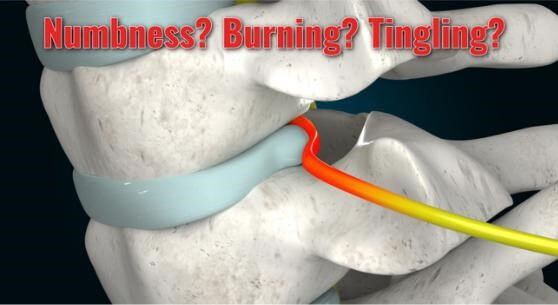
- A pinched nerve is a result of an encroachment or space occupying lesion. Most commonly, a herniated/bulging disc impinges upon a nerve causing numbness, tingling, burning, or pain. However, a pinched nerve can also be caused be a compression, constriction, or stretching.
- There are many pairs of spinal nerves because there are 33 bones in the spine. In between each bone a spinal nerve exits on the right and left. These nerves travel elsewhere to innervate (provide electrical impulses) other tissues. When a nerve is in a compromised state due to a biomechanical dysfunction, there is a negative downstream effect. (Hilton’s Law explains this well).
- There is an intervertebral disc between each vertebra that provides strength and mobility. These discs maintain a proper distance between each vertebra as to not encroach upon the exiting spinal nerve. If the disc loses height due to degenerative processes or an injury, a nerve can become pinched. The pinching can cause varying symptoms from mild numbness/tingling to sharp, radiating pain.
- Removing the biomechanical distortion via a gentle, safe, yet effective Upper Cervical Spinal Correction primary method of treatment at Crossroads Brain & Spine. Once the biomechanical distortion is removed and neurologic integrity of the spine restored, Non-Surgical Spinal Decompression may be necessary.
Testimonials
Dr Michael Lea and Lauryn are an incredible team. They have built this business together thoughtfully and with intention, and it shows in the excellence of care they provide. Dr Lea has provided me over 6 months of care to address my chronic health issues that I have been trying to resolve for over 10 years. I’ve seen countless physicians, PTs, chiropractors, etc – and lost faith in the possibility of ever really getting better (therefore, I follow through fairly poorly in what I was being offered). But after 6 months of consistent upper cervical care, the proof is in the pudding: my pre-treatment and post-treatment x-rays are drastically different. My skull, jaw, and pelvis are more aligned/level, my cervical and lumbar spine disc spaces have increased, and I’m putting more equal weight through my feet. I will be honest- even though I’m a medical professional myself and upper cervical care is evidence-based, I didn’t think it would work for me (mostly because nothing else ever has). But, I’m grateful for this improvement, and for the functional outcomes that are starting to bloom, like less headaches. I super appreciate Dr Lea’s model – let’s start with getting good data about your body (functional assessment, weight plates, x-rays, thermographic scan of your spine), decide if you even need upper cervical care – then start with frequent, consistent care, reassess after a period of time, and then decrease frequency, hopefully getting to a point where you need less and less care. I’ve been to so many doctors that just use me to fill their schedules- they provide a formulaic treatment and they never reassess to see if it’s working. Dr Lea and his team know what they’re doing. They’re bright, they’re person-centered, they’re kind, and they’re your kind of people. Trust me.
Johanna
